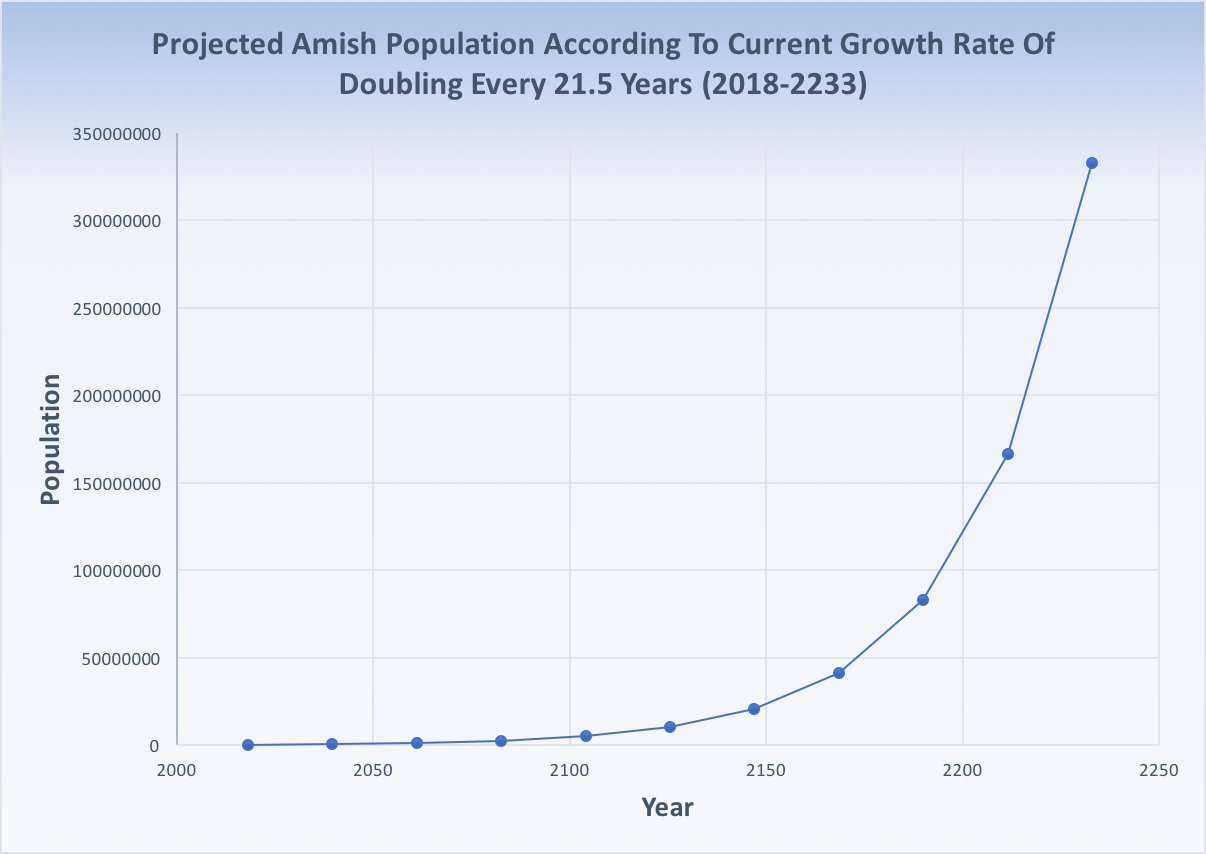If the United States Continues to Grow at This ‹ Rate It Will Take
The population of the Amish is projected to be greater than the current population of the United States in 215 years if the Amish growth rate, which has held constant for more than 100 years, remains the same.
Over the past 100 years, the Amish population has doubled every 19.63 years on average, according to data from Elizabethtown College.
Due in part to their opposition to modern birth control and the value they place on fertility, the Amish are one of the fastest growing populations in the world. Amish often use modern medicine and visit doctors, but some are hesitant to do so and prefer natural treatments. One study found that the Amish are less likely to seek medical care and more likely to delay care. The combination of natural fertility (fertility in a population that does not control or limit births) and modern health care results in exponential population growth. (RELATED: Study: Rare Genetic Mutation In Amish Boosts Lifespan)

The Amish have grown from 6300 in 1901 to 324,900 in 2018. (Data by Lyman Stone via Elizabethtown College)
The Amish have Swiss-German-Anabaptist origins and live in communities centered around church and family relationships, and are located across the United States and Canada, with heavy concentrations in Pennsylvania, Ohio, and Indiana. The majority of Amish are descended from about 200 families who immigrated to the United States in the 1700s. They reject much of modern technology in a effort to live in accordance with their interpretation of scripture, and are frequently seen using horse-drawn buggies instead of cars.
On average, the Amish have families larger than the typical American family, which has 1.9 children. Demographers estimate the Amish have an average of 6-7 children per family, according to Amish America. Some more conservative Amish settlements have even higher fertility rates. The Swiss Amish settlement in Adams County, Indiana, has an average of 9 children per family, according to Thomas J. Meyers and Steven M. Nolt's book "An Amish Patchwork."

A group of Amish children ride in a buggy near a one room Amish school house. (Photo by William Thomas Cain/Getty Images)
The population of the Amish has grown at extraordinary rates in the last century. The Amish population in 2018 was estimated to be 324,900, according to Elizabethtown College's Amish Studies Center. Twenty years ago, the Amish population was 169,442, and twenty years prior to that, the population was 69,653. In 1901, the total Amish population in the United States was 6,300.
"They're doubling their population about every 21 to 22 years, primarily because they produce large families and the vast majority of daughters and sons remain in the community as adults baptized into the faith, starting their own families and sustaining their religious beliefs and practices," said Ohio State researcher Joseph Donnermeyer.
It is not possible to project the Amish population in the distant future with absolute certainty, owing to the inevitable power of change. However, population projections based on Amish growth rates sustained for over a century show the power of exponential growth.
The Amish have kept their growth rate for over 100 years, and little evidence shows this growth rate changing. If the Amish continue to grow at their current rate, then they will surpass the current United States population (327.2 million people) in 215 years, provided no other factors impact or change the current growth rate.

By 2303, 332 million Amish people will live in the United States if the Amish growth rate of doubling every 21-22 years continues. (Data from Elizabethtown College)
In 100 years, 10 million Amish people will live in the United States and Canada if Donnermeyer's estimates of current growth continue.

The Amish will grow to over 10 million by 2126 if the current growth rate continues. (Data from Elizabethtown College)
One thing certain for the Amish is that young people are not abandoning their faith. Young Amish adults must choose whether or not to be baptized following their teenage years, and almost 90 percent of them choose to stay with their community, according to PBS. The Amish retention rate of 85 to 90 percent is significantly larger than the 37 percent retention rate for millennial mainline Protestants, according to the Pew Research Center.
The Amish religion stresses living in separation from the world, so as to avoid being corrupted by its influence. Ordung, the rule of the Amish church, has proscriptions on clothing, electricity, cars and telephones, and must be observed by all members of the community, lest they risk excommunication, or even shunning. For example, the Amish avoid electric power lines as they believe they make them "conformed to the world" and do not keep photographs as they believe photographs only cultivate their vanity.
Even if the Amish continue their rapid growth for only a few more decades, the Amish could impact American society more profoundly in the future as they are projected to hit one million members by 2050. As American society advances technologically, the Amish could be a growing presence that retains the past. Right alongside the rise of artificial intelligence, could be the rise of the Amish, pushing America into a divide between the past and the future.
Source: https://dailycaller.com/2019/07/31/amish-population-america-growth-rates/
0 Response to "If the United States Continues to Grow at This ‹ Rate It Will Take"
Publicar un comentario